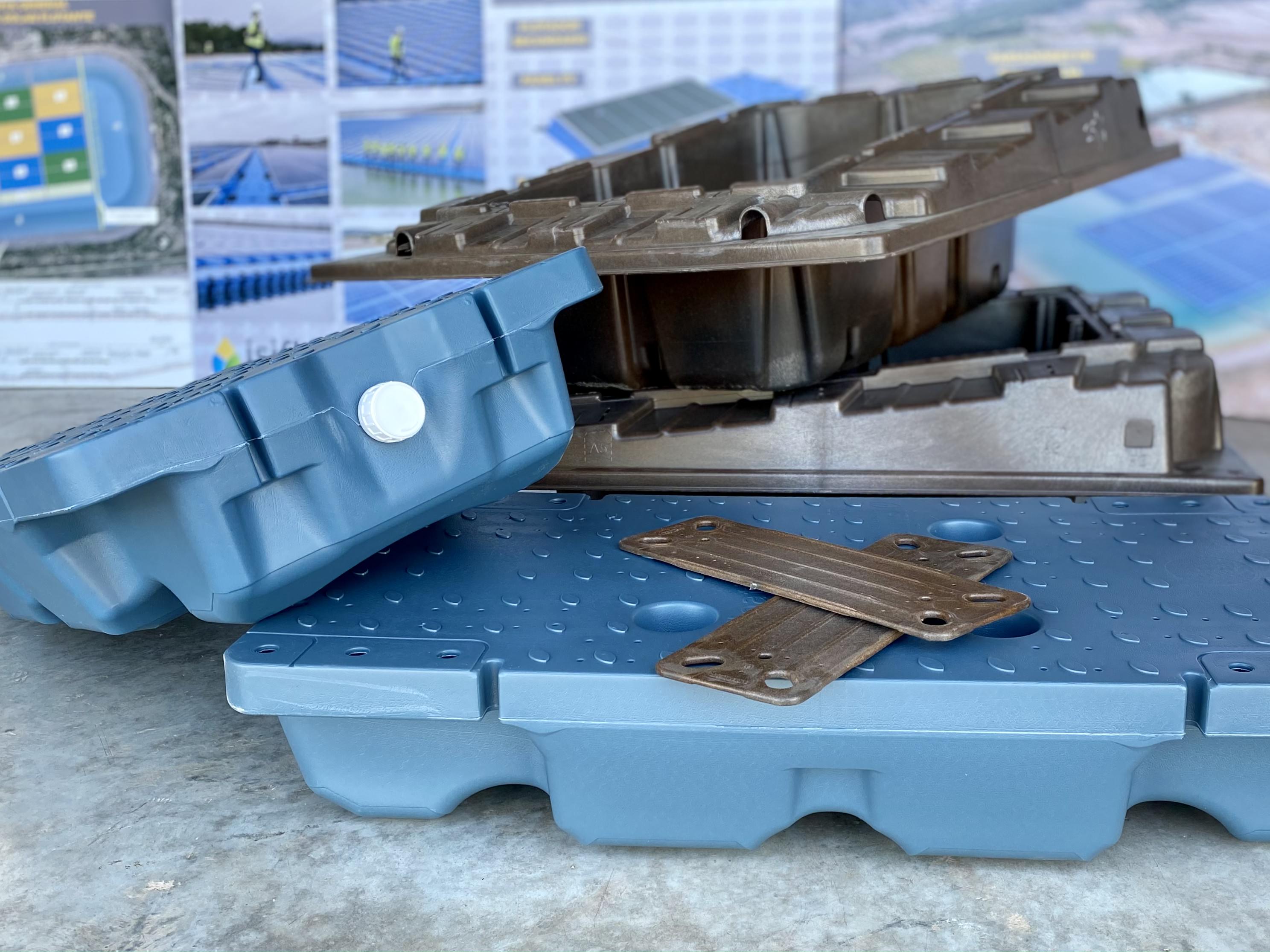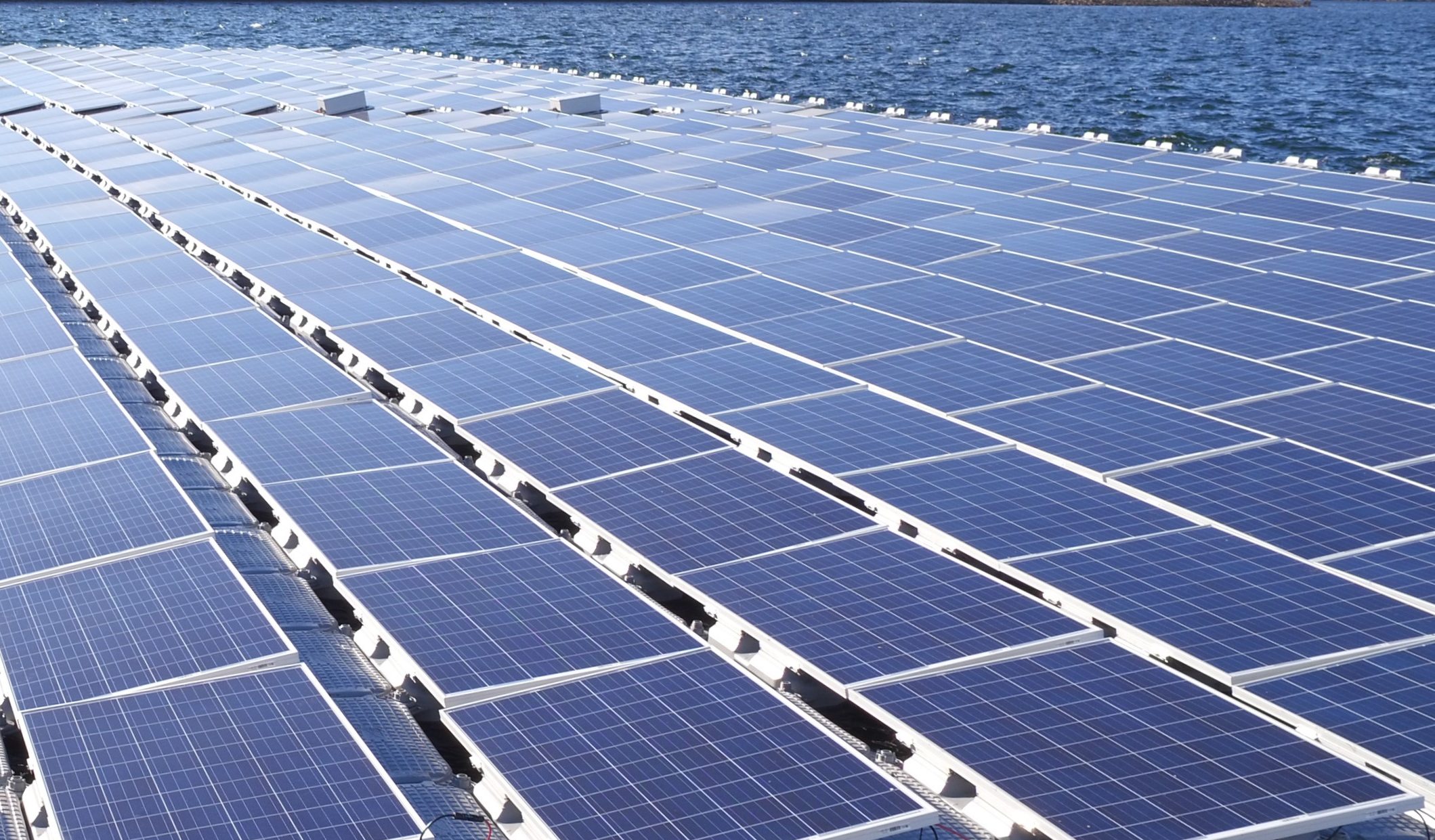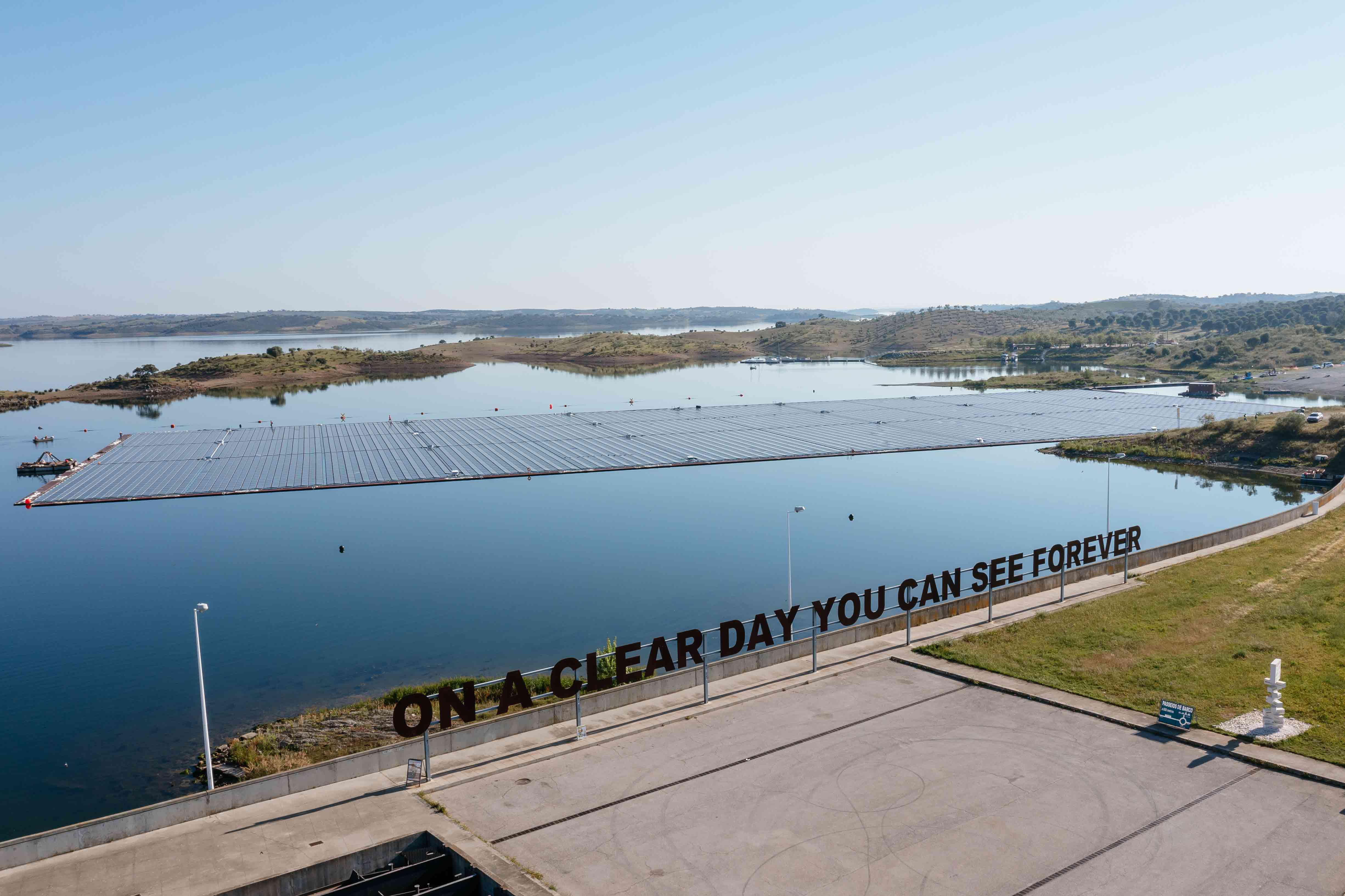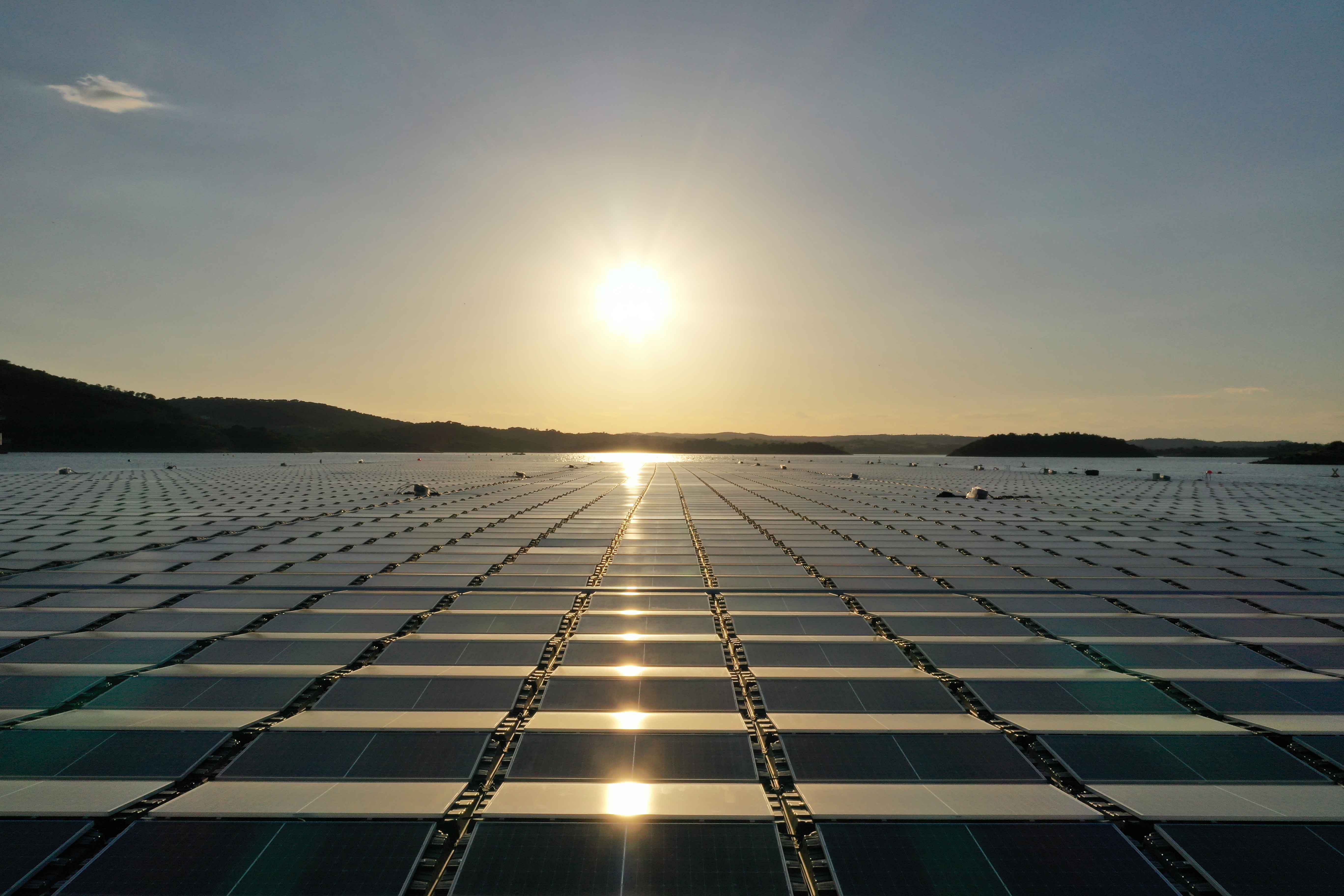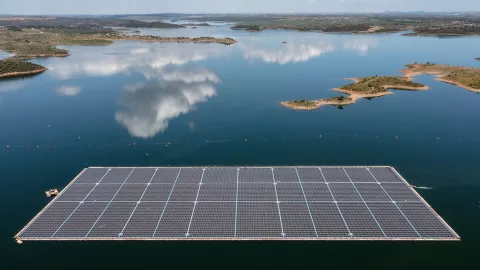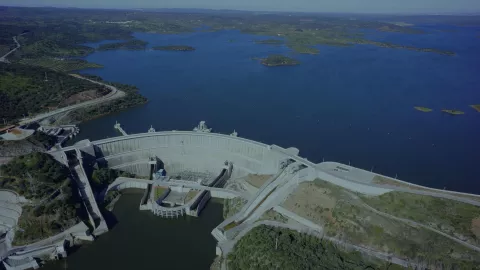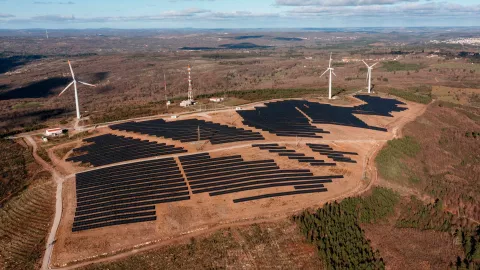Alqueva's floating solar panels - a pioneer in the hybridisation of renewable energies
Inaugurated in 2022, Alqueva´s floating solar power plant represents the future of energy: innovation and sustainability combined.
Initiated after a successful pilot project in the Alto Rabagão reservoir, Alqueva is now Europe's largest floating solar energy production platform and demonstrates how existing ecosystems can be used to increase renewable energy production without harming the natural environment.
This concept of combining multiple renewable energy sources in a single location is gaining traction worldwide, and Alqueva is at the forefront of this movement.
Recognised innovation: European Sustainable Energy Award
In 2023, Alqueva's floating solar project won the European Sustainable Energy Award (EUSEW) in the Innovation category, a prestigious prize awarded by the European Commission and in 2024, the 2024 Edison Prize, the highest honor in the electricity sector, awarded annually by the Edison Electric Institute (EEI), an association that represents all investor-owned electricity companies in the United States. These recognitions highlight Alqueva's role as a pioneer in renewable energy and its groundbreaking approach to the hybridisation of energy sources, scalable solutions that contribute to decarbonisation goals.
Innovate with what already exists: is this possible?
In a project of this kind, innovation takes place in several stages, from the initial concept to reality. A journey through these different stages is worthwhile to better understand the pioneering aspects and their undeniable benefits.
It is certainly exciting to create something from scratch. But innovation can also involve analysing what already exists and how it can be taken in a new direction. This was the thinking behind our project: to look at existing infrastructure, such as hydroelectric dams, and think about increasing their potential.
Maximising efficiency through hybridisation
By combining the vast expanse of water with solar energy, we came up with the idea of creating a floating solar power plant. The Alqueva project puts into practice the innovative
concept tested in the pilot project developed at the Alto Rabagão reservoir.
The same hybridisation idea has also been researched in other parts of the world, proving it is both feasible and an excellent solution with numerous advantages:
- Complementary energy production: The combination of hydro and solar energy sources allows for more effective use of a single grid connection point. This is the first time in Portugal that the concept of hybridisation, i.e., adding a new technology to the same grid connection point, has been implemented. The advantage is clear: connection points are scarce resources, but they are not used at full capacity throughout the day, meaning that spare capacity can be used to make them more effective.
- Utilisation of existing infrastructure: Another positive aspect of this project is that no new electricity transmission lines need to be built, as the floating power plant uses the existing infrastructure for the energy produced by the dam.
- Efficient use of a single grid connection point: The addition of a floating photovoltaic power plant is complementary to the dam, because generally speaking, when it rains (which benefits hydroelectric production), there is less sunlight and vice versa.
- Preservation of land: Building the power station on the surface of the reservoir behind the dam leaves land available for agriculture or recreational activities, for example, and has less impact on the environment and landscape than a land-based solution.

Hybridisation, combining electrical energy produced by water, sun, wind and storage, is a logical path for growth in which EDP continues to invest, enabling it to produce cheaper energy, optimise resources and reduce environmental impact.
The challenges of hybridisation
Deciding that a floating photovoltaic platform connected to the same connection point as the hydroelectric power plant would be the ideal solution, presented the project with another technical challenge: building it on a reservoir associated with a dam. Alqueva is the "largest reservoir in Europe", which may seem a title with little impact but, in reality, constructing on such a reservoir is an engineering challenge. It is located in very deep valleys (almost 70 metres deep), with steep banks, and the surface of the lake oscillated by more than 20 metres.
Given the configuration of the reservoir in the installation area, the depth at which the platform is moored varies, meaning special care was needed because its anchoring systems could not be fixed rigidly. This is so technically complex that other innovative projects are needed to gain experience and provide guidance, such as the FRESHER research project, which has tested different anchoring systems, including special elastic cables that allow the platform to follow the rise and fall of the water level.
As the level of the reservoir varies over the months, the moorings must be sufficiently elastic to allow for the changes in level between the minimum and maximum expected, while also ensuring that the platform does not move from its position, countering the action of the strong winds that blow in this area. This presented a complex engineering exercise that would be simpler in a concrete water reservoir, for example, which already exists in other parts of the world.
Welcome to the future of energy in Europe
It was also decided to add another layer of innovation: a battery with nominal power of 1 MW and storage capacity of around 2MWh is an essential element for maintaining grid stability in the case of renewable energy, because production is not linear, but unstable, dictated by the natural elements. When clouds appear or the morning is foggy, the solar energy production curve drops. Having a battery makes it possible to store the energy produced by the floating power plant at time of greater production (sun exposed) and to export this to the grid when solar production falls.
But energy storage is already commonplace in hydroelectric plants. At Alqueva, energy is stored in the form of water on days when there is an excess of this element, to generate energy on days when demand is higher. This is thanks to a
that runs on the energy produced by the floating solar power plant when it is activated.
This complex production hybrid has created a type of ecosystem very similar to how Europe will produce energy in the future when it has high penetration of renewables, enabling renewable energy use to be maximised and ensuring the stability of the grid, while having much lower environmental impact.
Reduced impact on the environment
"Behind the thinking that led to this project is the question: what can we do that has the lowest impact on the environment? We not only want to make a project that is solar, wind or from another renewable source, but one that has the lowest possible impact on the environment and minimises the use of natural resources as much as possible. This is what drives this type of project," says Miguel Patena, responsible for the Alqueva Floating Solar Photovoltaic Power Plant project at the time of its inauguration.
The Landscape is one of the most significant descriptors in environmental studies for this type of project and the impact may be considered positive by some and negative by others. Environmental concerns were actually part of the genesis of this project, not only through the investment in renewable energy and utilisation of infrastructure, but also in how the engineering was conceived, through innovation, to pioneer reductions in the environmental footprint.
Traditionally, the panels in a floating solar power plant sit on plastic floats. Looking to the future, and because EDP is committed to sustainability and with promoting the circular economy, EDP challenged Amorim Cork Composites, which markets cork, and Isigenere, which manufactures floats, to produce a float with lower CO2 footprint. Together, the three companies developed an unprecedented float, made with composites of cork and HDPE (recycled plastic), unlike alternatives, which are made entirely from virgin plastic.
As a result, these floats have a carbon footprint about 30% lower than traditional ones and the two companies plan to continue the partnership to develop carbon neutral floats. Its blue colour is well camouflaged in the water.
What do we have now and what does the future hold?
When crossing the large structure of the dam, pause for a moment in the middle to admire the future. On one side, the work of the artist João Louro, which celebrates the phrase "On a clear day you can see forever". On the other, a photovoltaic mirror rests on another mirror, the water surface. The set of approximately 12,000 panels – identical to those installed on the roof of a building, for example – floats on around 25,000 floats, over an area of four hectares.
They were installed with an inclination of 5 degrees and an east-west orientation, which may seem strange, since the panels on land, in Portugal, have an optimal inclination of 30 degrees and face south, but this is the best way to resist the wind and make use of the entire surface, reducing shadows and extending production hours. The result is 7.5 GWh of energy per year, which will benefit 1500 families in the region.
Although these figures are large, it should be remembered that the area of this platform is 6000 times smaller than the total area of the reservoir - in other words, the platform occupies the equivalent of 0.016% of the total area of the reservoir. "If 3% of the Alqueva area were occupied with solar panels, there would still be 97% of the area free for all other activities," explained Prime Minister António Costa, at the inauguration of the project in July 2022.
It is possible to continue to expand the production facility built here without cannibalising this area of incredible natural beauty and with many other uses for the local economy. Alqueva's future is one of continued growth and innovation. EDP plans to add 70 MVA of floating solar power to the existing capacity, secured in Portugal's first floating solar auction in 2021. This expansion will significantly increase renewable energy production without affecting the natural beauty or other uses of the reservoir.
These approximately 70 hectares of panels will not be connected to the dam's electrical infrastructure, but directly to the grid, and will be hybridised with wind, another complementary source to solar - in winter there is less sun and more wind, and vice versa in summer. There will be another 70 MVA in solar and 70 MW in wind turbines located a few kilometres from the reservoir.
The path to decarbonisation
Alqueva is more than just a renewable energy project; it is a blueprint for the future of energy in Europe. With the European Union aiming to become carbon neutral by 2050, projects like Alqueva are crucial to accelerating the transition to a greener economy.
EDP is leading the way, with a goal of becoming 100% green by 2030, and Alqueva's innovative hybridisation of renewable energy sources is a significant step towards this goal. The transition to achieve this future target has already begun and investment in solar energy is key.
The 2023 European Sustainable Energy Award is a testament to EDP’s leadership and innovation in the renewable energy sector. In the words of Miguel Stilwell d’Andrade, CEO of EDP, “Alqueva is today an example of innovation and sustainability, which we will soon be reinforcing with the new project won in the first floating solar power auction in Portugal”. With its ongoing commitment to innovation and environmental stewardship, EDP is not only contributing to the global decarbonisation effort - it is setting the standard for how it can be achieved.
"Alqueva is today an example of innovation and sustainability, which we will soon be reinforcing with the new project won in the first floating solar power auction in Portugal," said Miguel Stilwell d'Andrade, adding that, "EDP is a global pioneer in floating solar panels technology, which is a remarkable leap forward in the expansion of renewables and in accelerating the decarbonisation process".
